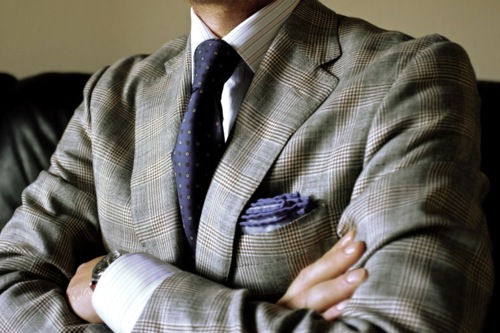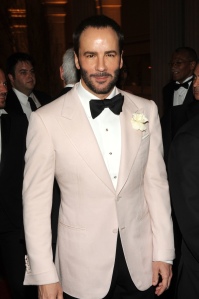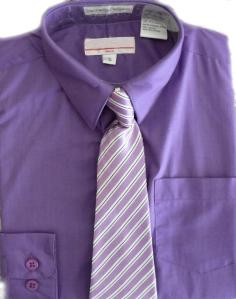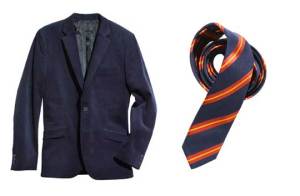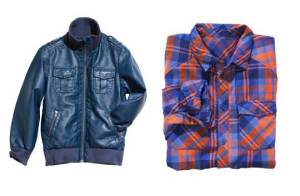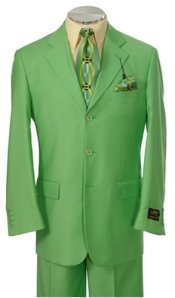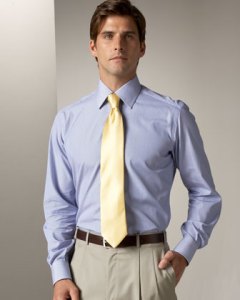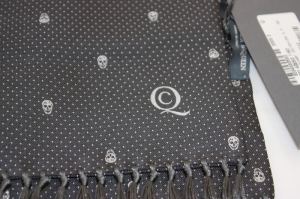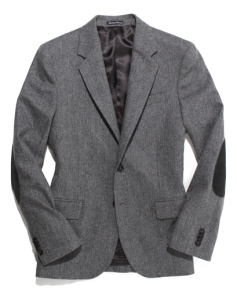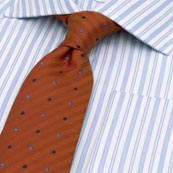INTRODUCTION
This blog isn’t about telling people that they should be obsessed with clothes, that they should dress like a parade of corporate clones or that they can’t show their personality in their wardrobe choices. In fact, far from it: it’s meant to be some words of advice from a fellow man on how you can tweak and upgrade your wardrobe without requiring a great deal of time or money (and, I also throw random, interesting stuff on here as well, such as biometric wallets, just for interest’s sake). There’s not one way of looking good, and it always annoys me when websites and forums claim that there is – with that said, there are some things that I believe are mistakes that do guys no favours and I believe there are certain basic rules that will serve you well.
Occasionally I’ll check my inbox and find a message from someone about this blog, asking me either: a) to post more (thanks, I really do appreciate the encouragement, please keep it coming – I’ll try to post more); or, b) asking for some sort of general sartorial guidance. This post is my attempt to kill two birds with one stone. These are my general rules for dressing – some of them I’ve gleaned from various books, my father and grandfather, or other sources; some should be obvious and yet I see them gone wrong all the time; others are because I’m a bit nit-picky; and still others are just things that I’ve adopted and I’ve found to work well. The common thread is that following these rules have helped to prevent me from at least looking like a jackass, which, as I’ve stated in the past, is one of the major goals of this blog. I’m hoping this article will be something that I update and add to regularly, so feel free to send in suggestions and check back regularly (I’ll post on Twitter, @oneguysstyle, whenever I make a significant addition).
Without further ado, here are an assortment of rules that I follow to jackass-proof my wardrobe, along with my reasoning for them. I’ve also divided them into categories – things you absolutely have to get right, things that you probably should get right, and things that may take your style game up that extra notch.
THE BASICS – YOU NEED TO GET THESE RIGHT
1. Fit is everything
It doesn’t matter what the label says; how much you paid for it; how much the retail price was; what store you bought it in.; or, what the “working for commission” sales associate said. If it doesn’t fit (and cannot be made to fit), it’s not worth it. That goes for suits, shirts, pants, jackets, belts or whatever else you can think of. A Uniqlo shirt can look better on you than a Brunello Cucinelli shirt, simply because the former fits better than the latter. Outside of Sweden, guys tend to wear clothes that are too big for them. I’m 6’2″, 175lbs and grandmas and aunts have long sent me “Large” sized clothes. In actuality I wear “medium” in most brands – use this as your benchmark. Just because you’re over 6’0″ doesn’t make you a “Large” (although it may make you a “tall”, depending on the length of your arms and torso). Wearing clothes that are too big for you make you look sloppy; and, contrary to common belief, they are no more comfortable than clothes that actually fit you.
The good news is, if you do have clothes that don’t fit (especially shirts) than a good tailor can likely work wonders (more about this in a minute). I’ve had shirts that I’ve bought (knowing full well that I’d be taking them to my tailor) that I could almost make a second shirt out of with the excess fabric – the only thing that fit when I got them was the collar. Don’t live your life trying to find ways to tuck in extra shirt fabric, or trying to keep pants from sliding down your ass, or looking like your jacket is wearing you rather than the other way around. Either don’t buy clothes that fit like that in the first place, or, if you already have, take them to a tailor. Clothes that fit will make you look slimmer, taller, more professional, sexier and better proportioned. There’s not attribute on that list that you don’t want. It’s really as easy as figuring out what fits and buying it (or having things altered to fit) – but I constantly see men that have ignored this rule. If you take nothing else from this list, at least understand the importance of Rule 1. Check out the pictures above. Clearly they represent something of a caricature, but it’s immediately clear to everyone when someone is wearing things that fit and when they’re not.
2. Find a tailor and understand what he or she can and can’t do
People associate tailors almost entirely with suits. This is like associating football entirely with quarterbacks – sure, they’re the most recognizable member of the team, but there are 50 other guys out there as well. In the same way, to simply go to the tailor to have your suits fit is to barely skim the surface of their capabilities. To whit, I recently purchased a polo shirt from a well-known manufacturer. I have a few of their shirts already, all in a particular size (they don’t use the typical “small”, “medium”, “large” sizing). I happened across a sale, was in a hurry and simply grabbed a shirt in what has always been my size and didn’t try it on. Unbeknownest to me, this particular maker has introduced a new fit and their sizes are now a little bit different than before – which meant that I now own a polo shirt that swamps me, that I can’t return. I took it to my tailor and, $12 later, I have a polo shirt that fits perfectly and I was even able to customize certain details of the shirt. At first this may seem ludicrous (tailoring a polo shirt? Really?). However, think of it this way. Before, I had an article of clothing that was essentially worthless to me – I couldn’t return it, and I would never wear it because it didn’t fit. Now, I have a polo shirt that I will wear, and fits me perfectly – $12 very well spent, in my opinion, as it saved a $35 investment from becoming worthless. Think of it this way: every pair of dress pants you buy needs to be tailored, just like every suit. If a shirt doesn’t fit perfectly, it needs to be tailored. I’ve tailored jeans that I liked, got a great deal on and wanted to keep, despite the fact that they didn’t quite fit (they now fit perfectly). I’ve had my tailor repair jeans and shirts that had ripped, thereby reviving some of my favourite articles of clothing. You can have ties narrowed, sleeves and armholes repositioned or narrowed, custom articles of clothing made, even t-shirts recut, sometimes for the price of buying you and a friend venti americanos and a muffin from Starbucks. More importantly, they can take something you never wear, that lingers in the back of your closet like a spectre because you don’t like how it fits, what it looks like, or a certain thing about it and make it your “go-to” article of clothing. Sometimes, you can go shopping in your own closet and find things that, with a little work, can be made new.
The only caveat is this: you need to know what a tailor can’t do. They can’t really do much for suits that don’t fit in the shoulders (so, make sure your suits fit there; you can do some tailoring to the body of the suit, if need be). They can’t remove shoulder pads, or reduce them. They can’t really adjust the collar size of a shirt. They can only work with the material you give them (i.e. you can’t have pants let out if there’s no material to let them out with. You can’t have pants lenghtened without material being there to do it.). It’s tough to adjust the rise of pants too substantially. There is a limit to how many sizes they can take an article of clothing down (sorry, but those size 42 pants cannot be made into 32s… The two back pockets will become one back pocket). Sweaters aren’t really their speciality. Re-working sleeves with functioning buttons is a problem (as it’s tough to move already made buttonholes without leaving very visible marks). So is substantially lengthening or shortening a jacket (the pockets will now be in a slightly odd position, and it’s expensive). Just like Superman had his limitations (kryptonite), so do tailors – in my experience, Superman is the most apt comparision for a great tailor.
3. Wear a tie darker than your shirt, 95% of the time
– This is a good experiment: walk into the suit section of Tip Top, Men’s Warehouse or other down-market men’s retailers – your eyes will be greeted with dress shirts in a ROY G. BIV assortment of colours. Mannequins will be rocking solid black, red, green, dark purple and even orange dress shirts. Then head over to one of the finer men’s stores in your area; I’ll toss out Harry Rosen, Niemen Marcus, Barney’s… any of those would be fine. Now check out what colour shirts the mannequins and floor displays have on – I guarantee that at least 90% will be wearing shirts where the predominant colour is either white or blue (they may have red, purple, pink, green, orange or any other colour represented via stripes or checks, but the shirt will almost definitely be rooted in white or blue). This isn’t an accident – solid black, red, orange, green and dark purple are not colours for dress shirts, unless you work as a magician in Vegas. For whatever reason, it looks better when your tie is darker than your shirt, and these colours generally make this difficult. They’re also tough colours to match and they’re definitely not traditional for business or just about any other form of social interaction. This isn’t to say that you can’t wear solid shirts in colours other than white or blue; pink and lavender can be nice colours for shirts. However, stick with pale rather than dark shades, and pair with a tie in a colour darker than your shirt (navy, dark grey, etc). Furthermore, I have no problem if you’re going to cocktail party in a dark space at night and want to wear a black dress shirt with a black suit and no tie (see Bradley Cooper on the left). If it’s nighttime and dark, and drinks are in the hands of many, then black may be an option (again, skip the tie) – but the look on the right is a train wreck. Ties and black shirts do not go together, especially at the office.
4. Suit, shoes, tie and then shirt should be your focus in terms of allocating your attention and resources
A nice suit is something you need and is the most noticeable part of your business or formal wardrobe. Plus, a suit is versatile, as it can be worn without a tie, just as a jacket with jeans or slacks, etc, or even the pants with a shirt and sweater. Suits are also the most difficult thing to get right. Shoes are the next most important as bad shoes can destroy a look, even if you have a nice suit, tie and shirt. Shoes can also be quite expensive and often demand a significant investment (although, if you purchase quality shoes, this investment should last a lifetime). Ties come third as a nice tie will get you noticed positively, and a bad tie will immediately get you noticed negatively – if you’re diligent, you can often find nice ties at relatively low prices without sacrificing quality (eBay, Holt Renfrew Last Call, Saks Off 5th Avenue, Century 21, etc, can be excellent sources for high quality ties at bargain prices). Furthermore, if you don’t own many suits, having a range of ties will make it seem like you have a wide ranging wardrobe. Finally, shirts should be your last area of focus, as you can find nice shirts quite easily at good prices (see my articles about Shirts (here) and TM Lewin (here)). The importance of shoes should really be underlined (I thought about putting them first). Don’t fall into the trap of spending $150 on shoes and $140 on a shirt. Spend $40 on a TM Lewin shirt, as per my post here, and $250 on the shoes (for some info about choosing shoes, read this post.
5. Don’t wear black suits or ties (or shirts) to work
Simply put, black is not traditional business wear, beyond shoes and belts. A black suit doesn’t look good under artificial light (and is susceptible to, and looks worse after, fading more than any other colour). Black ties are too formal for most workplaces (unless your job is hosting the Oscars, working at a funeral home or raising barns on the weekends with your Amish buddies). And, as I discussed earlier, don’t even think about wearing a black dress shirt to any workplace. Black is one of the hardest colours to match shirts and ties to. Choose navy, charcoal grey, mid-grey, light grey, dark brown or even khaki or beige (in the summer time) for suits before you go with black. This is especially important if you only have one or two suits, as your goal should be to maximize the number of colour combinations you can wear with your limited suit wardrobe. That said, black is great when it comes to evening activities; for suits, ties or shirts. So if you’re going out for a night on the town, as a 5th or 6th suit, or you’d like to wear it for other occasions that aren’t business related, think about black. But unless you work as a chaplain or are going door to door for the Church of Jesus Christ of Latter Day Saints (or were given the suit as wardrobe for your role in ‘Book of Mormon’), go with navy or charcoal for your suits at the office, and skip black shirts and ties.
6. Shoes polished. Always.
When I was in university and needed a pair of brown dress shoes, I found a pair of Brown’s Shoe Store’s private label shoes on sale and bought them. I couldn’t afford much more than a $75 investment and these looked nice enough for what they were and served me well. Being that my grandfather and father have instilled in me a pseudo fanaticism about keeping shoes polished, I made sure that they sparkled when I wore them. Amazingly, my $75 shoes got lots of compliments. I’ve since upgraded my shoe collection, but nonetheless, these experiences underline something vitally important – you can make decent shoes look substantially better when you take the time to keep them polished. I actually still have the shoes in my closet (the uppers remain in good shape, and, as they were glued, it was the soles that went first – I resoled them and they’re now my rainy day shoes). Conversely, you can make nice shoes look like cheap shoes if you do not polish them. Polished shoes will set you apart from the rest of the dull-shoed masses and undoubtedly engender compliments. How else can you upgrade your wardrobe for $3 (the price of a tin of shoe polish) and ten minutes of your time?
7. The bottom button of a two or three-button suit should always be left undone. The top button of a shirt worn without a tie should always be left undone too.
Not only is this the modern way of wearing suits, but, more importantly, suits are actually cut with the assumption that you will leave that button undone. If you do it up, it will often result in a pull at that button and change the balance of the suit. If you’re wearing a dress shirt (or casual button down, or polo shirt) without a tie, then leave the top button undone. If you’re not wearing a tie, then clearly the occasion is at least mildly informal, so you don’t need to do that button up. I realize that it’s hipster-chic to do these buttons up, but, at least in my mind, it doesn’t work for the majority of guys trying for this look. If you want to add formality to your outfit, wear a jacket, don’t do it with that damn top button. To my eyes, doing up the top button makes you look about as uptight as a nun in Vegas. Even the guys on The Big Bang Theory don’t do up their top buttons, and that’s a strong statement.
8. Step away from the cell phone belt holster
We get it, you have an iPhone, Galaxy or BlackBerry. So do most 11 year old girls. I’m sure you’re a very important man, who gets very important emails from very important people. That’s great. The good news is, those emails still manage to get to your phone when it’s in your pocket. This applies in equal measure to your pants pocket and your suit jacket pocket – you really don’t need to display your BlackBerry like you’re Wyatt Earp in Tombstone. I’ll make an occasional exception for individuals with holsters who wear suit jackets that will cover the holster, but grudgingly. Unless you’re a time traveller from 5 years ago and are stuck with a BlackBerry with a side scroll wheel, than your phone will be slim enough to be in your pocket with no discomfort, I can assure you. I covered this growing societal issue before here.
